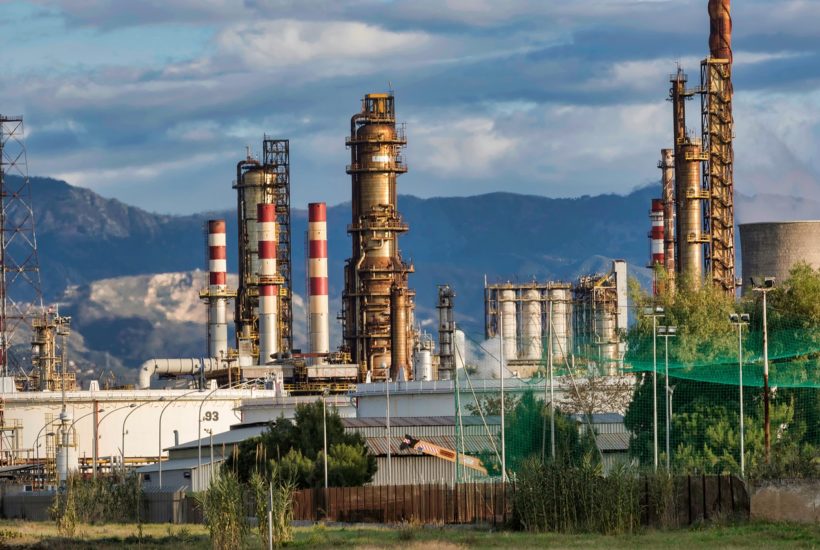Mining & Energy
Gas Prices Are Skyrocketing Across Europe
Gas prices on the EU market have increased by 484% since the beginning of the year and on Tuesday, October 5th, they exceeded $1,300 per thousand cubic meters. Gas is also getting more expensive in the US, where the shale boom over the past decade has brought prices down to minimal levels. Now gas is rising at a record pace in 13 years, but it can’t keep up with gas prices across the Atlantic.

The unprecedented rise in gas prices, which has given European countries an energy shock comparable to the oil crisis of the 1970s, has now hit the finances of the world’s biggest commodity traders, who have been betting massively on falling gas prices.
Glencore, Trafigura, Vitol, and Gunvor have received margin calls from brokers in the gas futures market. Thus, they were forced to obtain additional financing from banks, Reuters reported, citing sources familiar with the situation.
According to agency insiders, brokers are demanding hundreds of millions of dollars from commodity traders to hedge positions that were taken as part of hedging strategies.
Companies trading commodities – from metals to hydrocarbons – have followed the same pattern for years: if the difference between EU and US gas prices (known as the spread) is widening, they bet on narrowing it – that is, they open short positions on EU gas futures and long-term US gas futures.
If the spread narrowed, the opposite transactions were made: traders bet on an increase in gas prices in the EU and a decrease in the U.S., counting on the difference returning to historically average values.
Read more about the gas markets and the rising prices, and find the most important business news of the day with the Born2Invest mobile app.
However, the year 2021 has escaped all previous patterns and rules
Gas prices on the EU market have increased by 484 percent since the beginning of the year and on Tuesday, October 5th, they exceeded $1,300 per thousand cubic meters.
Gas is also getting more expensive in the United States, where the shale boom over the past decade has brought prices down to minimal levels. Now gas is rising at a record pace in 13 years, but it can’t keep up with gas prices across the Atlantic. By comparison, U.S. gas at the Henry Hub costs $5.97 per million British thermal units (MMBtu), and at the Dutch TTF hub, it costs nearly $34 per million MMBtu.
According to Reuters, it is commodity traders who hold the bulk of the short-term gas contracts on the London ICE exchange. According to these contracts, it reaches $30 billion.
Some commodity traders are raising funds from banks to cover hedging requirements. Others are thinking of closing positions, but this could lead to a further increase in quotations: companies will have to buy contracts out of the market, which will create artificial, “paper” demand.
The situation is particularly tough for small traders and medium-sized companies, Reuters sources say. They cannot afford further loans to secure margin call terms.
The rise in gas prices in Europe started in the first half of the year when demand rebounded after a pandemic and LNG supplies fell sharply. Tankers sailed en masse to Asia, where fuel costs are higher.
Over the summer, Russia’s Gazprom, which is lobbying for the Nord Stream 2 pipeline, decided to turn up the heat. In July, the Russian company cut supplies to Europe by 10 percent. In August, it abruptly and drastically stopped pumping gas through the Yamal-Europe pipeline and stopped selling gas through its electronic platform, where customers could accept additional volumes beyond those booked in long-term contracts.
Since September, Gazprom has refused to book additional capacity on Ukraine’s gas transmission system, reducing pumping by 12 percent, and since October it has again turned off the tap on the Yamal-Europe pipeline, cutting supplies three times.
__
(Featured image by nicolagiordano via Pixabay)
DISCLAIMER: This article was written by a third party contributor and does not reflect the opinion of Born2Invest, its management, staff or its associates. Please review our disclaimer for more information.
This article may include forward-looking statements. These forward-looking statements generally are identified by the words “believe,” “project,” “estimate,” “become,” “plan,” “will,” and similar expressions. These forward-looking statements involve known and unknown risks as well as uncertainties, including those discussed in the following cautionary statements and elsewhere in this article and on this site. Although the Company may believe that its expectations are based on reasonable assumptions, the actual results that the Company may achieve may differ materially from any forward-looking statements, which reflect the opinions of the management of the Company only as of the date hereof. Additionally, please make sure to read these important disclosures.
First published in msn, a third-party contributor translated and adapted the article from the original. In case of discrepancy, the original will prevail.
Although we made reasonable efforts to provide accurate translations, some parts may be incorrect. Born2Invest assumes no responsibility for errors, omissions or ambiguities in the translations provided on this website. Any person or entity relying on translated content does so at their own risk. Born2Invest is not responsible for losses caused by such reliance on the accuracy or reliability of translated information. If you wish to report an error or inaccuracy in the translation, we encourage you to contact us.

-

 Impact Investing1 week ago
Impact Investing1 week agoGlobal Energy Shift: Record $2.2 Trillion Invested in Green Transition in 2024
-

 Crowdfunding5 days ago
Crowdfunding5 days agoDolci Palmisano Issues Its First Minibond of the F&P “Rolling Short term” Program
-

 Markets2 weeks ago
Markets2 weeks agoShockwaves of War: U.S. Strikes Iran, Markets Teeter, Global Risks Rise
-

 Fintech2 days ago
Fintech2 days agoRipple Targets Banking License to Boost RLUSD Stablecoin Amid U.S. Regulatory Shift
























